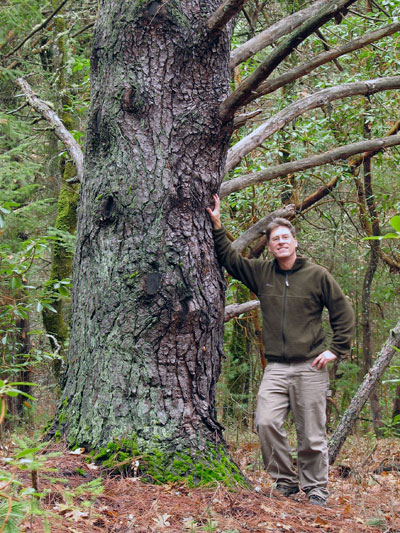|
National champion trees found in Josephine County
 |
|
Paul Brown stands next to his national champion knobcone pine, located in Cathedral Hills Trail System south of Grants Pass. |
Josephine County is home to the largest knobcone pine and Brewer spruce in the United States, after two local tree hunters discovered and nominated them. The knobcone is located in Cathedral Hills Trail System while the Brewer spruce is near Tanner Lake. o o o oBy Zach Urness of the Daily CourierPaul Brown never expected his wanderings through the Cathedral Hills Trails System would turn up a national champion tree.The former park ranger and wildlife illustrator simply liked strolling through the woods, enjoying the patch a forest six miles south of Grants Pass.But during a hike in January of 2010, Brown found something that gave him pause — a massive knobcone pine growing at the midway point of Ponderosa Pine Loop.“I’d passed the tree a few times before I realized it was a knobcone,” said Brown, who’s lived in Grants Pass for 11 years. “It’s really unusual because they tend to be much smaller and grow in places with a serpentine soil structure.“This one is growing very happily in the bottom land.”Growing happily is something of an understatement.The knobcone that Brown discovered is the largest in the United States, according to American Forests’ 2012 National Register of Big Trees.The tree’s measurements — 117 feet tall, 118-inch circumference and 51-inch average crown spread — were recorded in the Washington nonprofit’s 78-page booklet containing the largest known species of every tree in the country. The crown spread is the distance branches grow away from the tree’s trunk.“Among us tree geeks, it’s a pretty cool thing,” Brown said. “I didn’t go into this thinking it would happen.”Brown’s knobcone isn’t the only newly-minted national champion in Josephine County.The largest Brewer spruce in the United States also can be found locally, in the alpine area near Tanner Lake southeast of O’Brien.The tree was originally found by Central Point’s Frank Callahan about 10 years ago. But last summer, along with the class he taught at the Siskiyou Field Institute, he officially measured and nominated the tree for consideration.Turns out, it’s the country’s largest.The Brewer spruce stands 120 feet, with a 237-inch circumference and a 36-inch crown spread.“It was lots of fun measuring and nominating the tree as part of the class,” said Callahan, who has found more than seven national champion trees on the West Coast. “It’s a neat thing. The big trees work as a catalyst to open people’s eyes and get them into the field.”The process of nominating a state and national champion tree is fairly simple.The Portland-based nonprofit Ascending the Giants maintains the Oregon Department of Forestry’s big tree database, which includes 137 different species.The group takes nominations from people such as Brown and Callahan, who nominate them by sending in pictures and measurements.If the nominated tree is the largest on record, they send out a local expert to verify the tree’s measurements. The measurements can then be sent to American Forests in Washington for national consideration.“We feel it’s important to keep track of champion trees for the simple reason that many of the biggest ones are long gone,” Brian French, president of Ascending the Giants, said in a 2010 Daily Courier story. “We want people to know what a tree really should look like. And it really doesn’t take much to nominate a tree.”Both of Josephine County’s champions can be found without too much trouble.The knobcone pine is the easiest. The tree is located in a flatland area at a bend in Ponderosa Pine Loop, at about the midpoint of the trail of Cathedral Hills.The tree doesn’t stick out as much as a person might expect because it’s surrounded by faster-growing species such as Ponderosa pines, Douglas firs and black oaks.Those surroundings help explain why the tree has grown so abnormally large.“It has to focus on growing to keep from being shaded by the other trees,” Brown said. “And it’s more than holding its own.”The best way to identify the knobcone is its smooth, grayish bark that contrasts with trees around it.Locating the Brewer spruce requires a little more work. According to Callahan, the tree can be found in the glacial cirque above Tanner Lake. The tree seems to grow out of a large rock.“I would bet that there’s more (national champion) trees in Josephine County, just waiting to be found,” Callahan said. “All you have to do is get outdoors and look.”NOTE: Visiting the national champion Brewer spruce will be part of a Siskiyou Field Institute class this summer called “Big Trees of the Tanner Lakes Basin,” a course that will be taught by Callahan. To register for the class, visit www.thesfi.org or call 541-597-8530.Josephine County national championsKnobcone pine (Pinus attenuata)Height — 117 feetCircumference — 118 inchesAverage crown spread — 51 inchesLocation — midway point of Ponderosa Pine LoopNominator — Paul BrownBrewer spruce (Picea breweriana)Height — 120 feetCircumference — 237 inchesAverage crown spread — 36 inchesLocation — Tanner Lakes basinNominator — 2011 Siskiyou Field Institute Conifers Class
| |
|





